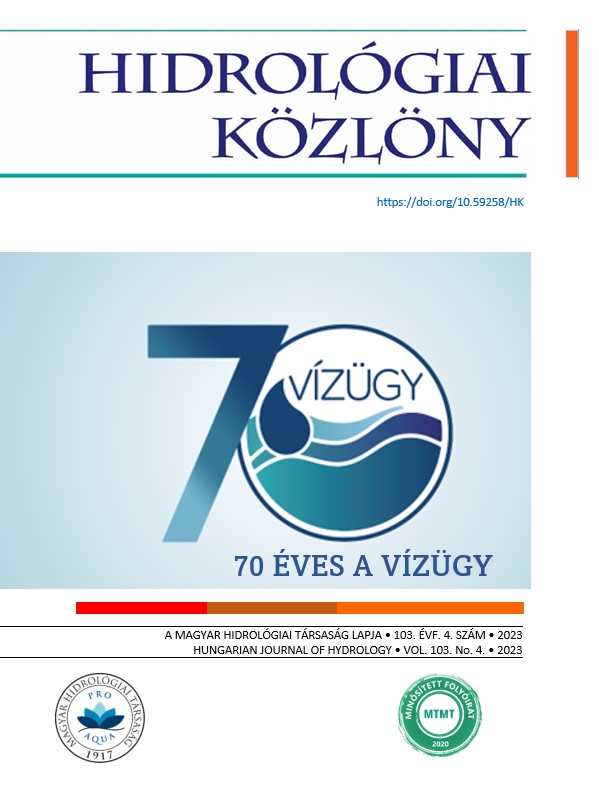Nagyfelbontású Repülőgépes Monitoring Hálózat módszertanának alkalmazása nádas mintaterületen, a tihanyi Külső-tavon
Absztrakt
A természetközeli ökoszisztémák a kis változásokra azonnal és érzékenyen reagálnak. Az antropogenitás növekedésével párhuzamosan az előhelyek mozaikossága is fokozódik, ami az élőhelyek állapotromlásához vezethet. Éppen ezért a vizes területek megőrzésére, védelmére, fenntartására kiemelkedő hangsúlyt kell fektetni. A Nagyfelbontású Repülőgépes Monitoring Hálózat (NRMH) alkalmas a változások követésére, így a nád monitorozására is. A módszer fejlesztését a táj térszerkezetében végbemenő gyors változások indokolták. A változásokra való reagálás igénye a nehezen megközelíthető terepen megtalálható területek gyors és költséghatékony felmérését tette szükségessé. A szubcentiméteres (centiméter alatti felbontású) részletességű ortofotók kis, pár négyzetkilométeres területek térképezését teszik lehetővé gazdaságosan, így a tájrészletek ilyen mélységű értékelése mintaterületek kijelölésével oldható meg. A tihanyi Külső-tó területének felszínborítása jelentős változásokon ment keresztül az elmúlt években, a tó felszínének jelentős részét az egybefüggő nádas foglalja el. Az NRMH vizes élőhelyekre vonatkozó felszínborítási kategóriarendszere hat új kategóriával bővült a tó vizsgálatán keresztül.
Hivatkozások
Bakó G. (2019b). Repülőgépes megfigyelőhálózat. Élet és Tudomány. 64(8). pp. 242-244.
Bakó G., Molnár Zs., Szilágyi Zs., Biró Cs., Morvai E., Ábrám Ö., Molnár A. (2020). Accurate Non-Disturbance Population Survey Method of Nesting Colonies in the Reedbed with Georeferenced Aerial Imagery, Sensors. 20(9). 2601. https://doi.org/10.3390/s20092601
Bakó G., Molnár Zs., Bakk L., Horváth F., Fehér L., Ábrám Ö., Morvai E., Bíró Cs., Pápay G., Fűrész A., Penksza K., Pácsonyi D., Demény K., Juhász E., Dékány D., Csernyava L., Illés G., Molnár A. (2021). Toward a High Spatial Resolution Aerial Monitoring Network for Nature Conservation – How Can Remote Sensing Help Protect Natural Areas? Sustainability. 1 (16). 8807. https://doi.org/10.3390/su13168807
Berényi A., Pongrácz R., Bartholoy J. (2021). Csapadékszélsőségek változása Európa déli alföldi régióiban az 1951-2019 időszakban. Modern Geográfia. 16(4). pp. 85-101. https://doi.org/10.15170/MG.2021.16.04.05
Czigány B., Pirkhoffer E., Balassa B., Bugya T., Bötkös T., Nagyváradi Gyenizse P., Lóczy D., Geresdi I. (2010). Villámárvíz mint természeti veszélyforrás a Dél-Dunántúlon. Földrajzi Közlemények. 134(3). pp. 281-298.
Demény K., Centeri Cs. (2012). A Gödöllői-dombság tájtörténeti elemzése katonai térképek alapján. VI. Magyar Földrajzi Konferencia, Szeged. Konferencia tanulmánykötete, pp. 155-164.
Dömötör D. (2011). Tihanyi-félsziget Külső-tavának hosszú idejű vízszintváltozásainak elemzése távérzékelt állományok retrospektív elemzésével. RS&GIS Távérzékelési, fotogrammetriai és térinformatikai szakfolyóirat I. 1 (1).
Dömötörfy Zs., Pomogyi P. (1997). A KBVR vegetáció-térképezés módszerei. Hidrológiai Közlöny. 77(1-2). pp. 48-49.
Dövényi Z. (szerk.) (2010). Magyarország tájainak kistáj katasztere. MTA Földrajztudományi Kutatóintézet, Budapest.
Futó J., Vers J. (2014). A tihanyi Külső-tó. Élőhely védelem és helyreállítás a Balaton-felvidéki Nemzeti Park Igazgatóság működési területén. Élőhelyvédelmi füzetek 7., Prospektus Nyomda, Veszprém.
Fülöp S., Dömötörfy Zs., Pomogyi P. (2006). A mocsári növényzet állapotának GIS alapú térképezése a Kis-Balaton Védőrendszer Ingói-berkében. Földrajzi Értesítő. 55(1-2). pp. 37-51.
Gyenese T., Zlinszky A., Albert G. (2019). A Balatoni nádasok pusztulása és regenerációja a mederdinamika függvényében. Földrajzi Közlemények. 143. 3. pp. 197-209. https://doi.org/10.32643/fk.143.3.1
Havril T., Tóth Á., Mádlné Szőnyi J., Müller I., Simon Sz., Péntek Cs., Molson J. (2013). Tavak és felszín alatti vizek kölcsönhatásának vizsgálata terepi és numerikus szimulációs módszerekkel a Tihanyi-félszigeten. In: Ünnepi kötet Müller Imre professzor 75. születésnapja tiszteletére. ELTE TTK Földrajz és Földtudományi Intézet, Budapest.
Kertész Á. (2010). Hogyan értékelhető a tájváltozás? In: Szilassi P., Henits L., (szerk.): Földrajzi Tanulmányok V., Tájváltozás értékelési módszerei a XXI. században, Tudományos konferencia és műhelymunka tanulmányai, JATE Press. pp. 125-134.
Konecsny K. (2015). Változások néhány dunántúli vízfolyás kisvízi vízjárásában. In: Szlávik L., Gampel T., Szigeti E.(szerk.) XXXIII. Országos Vándorgyűlés. Szombathely, 2015. július 1-3. Budapest, Magyarország: Magyar Hidrológiai Társaság (MHT). pp. 1-20.
Kozma-Bognár V., Szeglet P., Soós G., Pintér Á., Anda A., Pomogyi P. (2015). Kis-Balatoni vegetációk tér-idő változásának vizsgálata. Georgikon Journal. 19(1). pp. 23-28.
Marosi S., Somogyi S. (1990). Magyarország kistájainak katasztere II. MTA Földrajztudományi Kutató Intézet, Budapest.
Molnár Zs., Góber E. (2020). Repülőgépes adatgyűjtés a fenntartható jövőért. Természettudományi Közlöny. 151(2). pp. 66-69.
Németh K., Martin U., Harangi Sz. (2001). Miocene phreatomagmatic volcanism at Tihany (Pannonian Basin, Hungary). Journal of Volcanology and Geothermal Research. 111(1-4). pp. 111-135. https://doi.org/10.1016/S0377-0273(01)00223-2
Pácsonyi D. (2023). A Kis-Szénás mintaterület. https://www.interspect.hu/NRMH/html/10.html (2023. május 23.)
Pácsonyi D., Bakó G. (2022). Az NRMH Módszertanának fejlesztése a Budai Sas-hegyen. Tájökológiai Lapok. 20(1). pp. 107-122. https://doi.org/10.56617/tl.3382
Pinczés P. (2023). Pilis-oldal erdőrezervátum és Pilis-Tető mintaterület. https://www.interspect.hu/NRMH/html/11.html (2023. május 23.).
Pomogyi P., Reskóné Nagy M., Szilágyi F. (2007). A Balaton és a Velencei-tó, valamint vízgyűjtőjük speciális monitoring hálózata kialakításának makrofita szempontjai. Magyar Hidrológiai Társaság XXV. Országos Vándorgyűlése. Tata 2007. július 4-5. p. 14.
Pomogyi P., Szalma E. (2006). A VKI szerinti makrofita minősítő rendszer leírása. https://enfo.hu/sites/default/files/Makrofita%20minosito%20rendszer.pdf (2023. május 8.)
Rakonczay Z. (2002). Természetvédelem. Szaktudás Kiadó Ház, Budapest.
Szabó B., Centeri Cs., Vona M. (2011). Turai legelő Természetvédelmi Terület és környezetének tájváltozás vizsgálata katonai térképek alapján. Tájökológiai Lapok, 9(1). pp. 1-11. https://doi.org/10.56617/tl.3818
Szabó M., Timár G., Győri H. (2004). A Csicsói-holtág (Alsó-Csallóköz) kialakulása és fejlődése – a tájhasználat és a vizes élőhelyek változásai. Tájökológiai Lapok, 2 (2). pp. 267-286. https://doi.org/10.56617/tl.4600
Uj B., Nagy A., Saláta D., Laborczi A., Malatinszky Á. Bakó G., Danyik T., Tóth A., S. Falusi E., Gyuricza Cs., Pótig G., Penksza K. (2015). Wetland habitats of the Kis-Sárrét 1860-2008 (Körös-Maros National Park, Hungary). Journal of Maps, 12. pp. 211-221. https://doi.org/10.1080/17445647.2014.1001799
Vers J. (2002). Természetvédelem az ezredfordulón – In: Futó J. (szerk.): A Balaton-felvidék természeti értékei III. – A Tihanyi-félsziget. Balaton-felvidéki Nemzeti Park Igazgatóság, Veszprém.
Zlinszky A., Tóth A., Pomogyi P., Timár G. (2011). Initial report of the aimwetlab project: Simultaneous airborne hyperspectral, lidar and photogrammetric survey of the full shoreline of Lake Balaton, Hungary. Geographia Technica. 1. pp. 101-117.
Internet1: https://vizeink.hu (2023. május 16.)
Internet2: www.interspect.hu/NRMH.htm
Internet3: https://eletestudomany.hu/wp-content/uploads/2022/02/1-32.jpg (2023. május 17.)
Internet4: https://www.interspect.hu/NRMH/html/hramn-lc.html
22/1998. (II. 13.) Korm. rendelet a Balaton és a parti zóna nádasainak védelméről, valamint az ezeken folytatott nádgazdálkodás szabályairól.
Copyright (c) 2023 Krisztina Demény , Gábor Bakó, Zsolt Molnár, András Molnár, József Vers

This work is licensed under a Creative Commons Attribution-NonCommercial-ShareAlike 4.0 International License.




